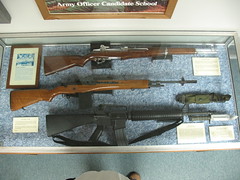The National Infantry Museum
Sunday 5 August 2007
1600
Fort Benning is the “Home of the Infantry”. Among the interesting things here on post is the National Infantry Museum. I spent Saturday afternoon visiting it.
It was an interesting visit and a pleasant way to spend the afternoon, even though there was not much there that I hadn’t seen before someplace else. I did see a few firearms and pieces of equipment that I had previously seen only in books, so that made it worthwhile.
One thing I noticed that was somewhat different from most of the other museums I have visited was the extensive use of personally-donated uniforms and artifacts. Many of the display cases housing uniforms and equipment were labeled in the style “This is the uniform worn by Major So-and-so when he served as thus-and-such in this-or-that war”. The only other museum I can remember that was so completely dominated by this type of display was the Yankee Air Force Museum at Willow Run Airport near Detroit (which unfortunately burned down a couple of years ago). Another interesting thing was that many of the enemy artifacts were designated as to who captured them and when.
There were quite a few displays from the first Gulf War (Desert Storm) and from the wars in Afghanistan and Iraq. It seemed strange to see these things in a museum since they seem so contemporary to me. But I guess it was already 15 years ago, and a whole generation is growing up who don’t remember it. For that matter even the Vietnam exhibits seemed relatively current to me, and as usual the most interesting exhibits were those from WWII and earlier.
I took my camera, thinking I would take a lot of pictures, but since much of it was repetitive I didn’t take very many. There were just a couple of exhibits that I decided to photograph:

Hermann Goering's Field Marshall Baton
Originally uploaded by hkp7fan.

M14 Rifle #0001
Originally uploaded by hkp7fan.
The M14 (in the middle) was adopted in 1957 to replace the M1 Garand. In the opinion of many people it is the best battle rifle ever fielded by the US Army. I certainly concur with that assessment. Unfortunately, in addition to being the main battle rifle, it was expected to replace the BAR as the squad automatic weapon. Because it was difficult to control on full-auto, it fell out of favor and was replaced by the M16 in 1965, Of course the M16 is inadequate as a squad automatic weapon as well, but things like that seldom seem to matter when it comes to weapons procurement.
At bottom in the picture is M16A2 serial #0001. The M16A2 was the third major version ot the M16, and was the one in which most of the deficiencies of the earlier models were finally corrected, making it a half-decent battle rifle. I still prefer the heavier .30 caliber round of the M14.
The M16 is ill-suited for desert warfare because of its sensitivity to dust and the limited efffective range of the round. Additionally, the 5.56 mm (.223 cal. ) round cannot penetrate walls as well as the 7.62 mm (.30 cal. ) round of the M14, so it is less useful in urban warfare.
Troops in Iraq have been clamoring for M14's for years now, and every one that can be scrounged up in the system has been sent there. Of course most of them were destroyed during the 1990's by the Clinton Administration, who sent about 750,000 perfectly serviceable M14 rifles into the jaws of "Captain Crunch", the crushing machine at Anniston Army Depot. Thanks, Bill and Hillary.
I spent the late afternoon at the internet café, but the connection was so slow it was unusable. Then I kicked around a bit and finally just went to bed. I ended up sleeping quite a long time, so I guess I needed it.
Today is for catching up on administrative and housekeeping duties such as backing up my computer and trying to free up some hard disk space.
Mood: Rested
Music: BAP - Dreimahl Zehn Jahre


0 Comments:
Post a Comment
<< Home